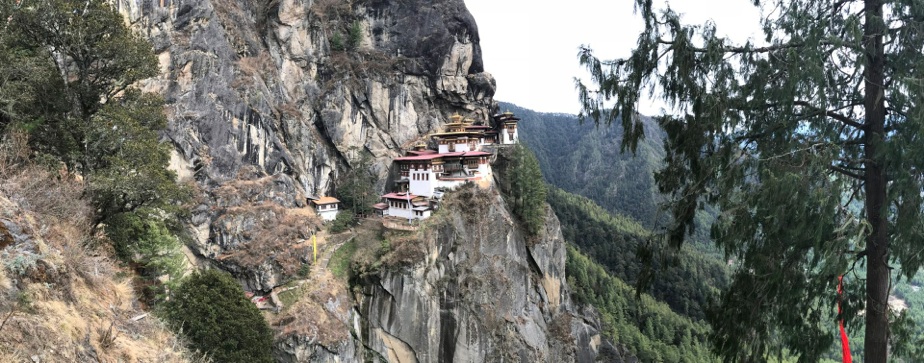Balkans 2016
Balkans 2016 Albania Kosovo Macedonia

Bhutan
2018
The fitness stats on my iPhone tell the story of today’s experience, a trek that took most of the day – 13 kilometres of walking, 22,000 steps and the equivalent of 190 floors climbed.
After a breakfast that was remarkable for its bland mediocrity, we set out at 8:30am for the drive to the base for the trek to Tiger’s Nest Monastery, or as it is known in Dzongkha (the national language of Bhutan), “Taktshang Ghoempa”. The drive through the Paro Valley countryside was scenic, and we were able to take in the beauty quite thoroughly as the speed limit on the road was just 30 kilometres per hour, and our driver (Tinle) is very law abiding. To be fair, we did need to dodge several monks prostrate on the roadway making a pilgrimage upcountry, and that is something not done best at high speed.
Tiger’s Nest Monastery is widely regarded as one of Bhutan’s scenic highlights. It is also one of the country’s most photogenic sights as the monastery seems to hang off what appears to be a near-vertical cliff. Built in the mid-1600s, its inaccessibility makes it a focus for pilgrims as the steep climb enables Buddhists to earn a very considerable amount of merit by making the climb, assuming of course that they don’t take the easy option of hiring a horse to ride for the first half of the trek.
The trail begins at an altitude of 2,630 metres and climbs up to the monastery’s entrance, which is at 3,240 metres, a height that can cause altitude sickness in many folk. Apparently fewer than half the people who begin the trek make it all the way to the monastery, and as such, some quite dire warnings abound.
The initial section of the walk began in a pine forest, but soon rose sharply to a ridge adorned with prayer wheels and prayer flags, which gave the first clear overview of the monastery. A few minutes further on, a cafeteria offered tea and coffee as welcome refreshments. Situated at an altitude of 2,940 metres, it had taken us just one hour to reach in spite of many (and I mean ‘many’) stops for photos.
The second section of the trek was a little more arduous, and took us an hour and a half, including many obligatory photo stops. Rather than a simple climb up to the monastery, the first part this section of the trek involved a steep uphill climb to a spectacular viewpoint at 3,140 metres, which gave views looking across a deep gorge to the monastery seemingly perched on the side of the cliff.
This was a bit of an illusion, however, because to reach the monastery, we had to descend a long, winding, set of steep steps that took us down a couple of hundred metres before climbing an equally steep, winding set of stairs to the monastery entrance at 3,240 metres.
Unfortunately, I can’t share any photos of the interior of the monastery, or even the external views of buildings within the monastery complex, as all cameras and phones must be left at the entrance. Apparently this is for safety reasons as several visitors and even some guides have fallen from the monastery down the steep cliff to their deaths. To add a perhaps gratuitous additional detail, the rugged, inaccessible terrain means the bodies are just left where they fall because they are regarded as unrecoverable.
The interiors of the monastery are among the best executed works of art I have ever seen; the beautifully crafted detail, the exquisite use of colour, and the overall grandeur of the concepts employed are simply breathtaking.
The return trek downhill took a similar two and a half hours of walking, interspersed by another welcome coffee and biscuit at the ‘halfway’ cafeteria. Needless to say, we were tired when we reached the base of the track, but exhilarated because we had managed to accomplish something that many others had failed to achieve, we had done so painlessly (indeed, enjoyably), and we had seen one of the great sights of the world.
Although Tiger’s Nest Monastery was our main objective for the day, there was time left for two other short visits. The first was a visit to the Kyichu Lhakhang, a lovely temple situated beside the road back into Paro. One of Bhutan’s oldest and most beautiful temples, it is believed to have been built in the year 659. Although we were too late in the day to see the main prayer hall, which like the Potola Palace in Lhasa is dedicated to the future Buddha, we were able to see one small prayer hall (but not take pictures) and explore the beautiful grounds. My overwhelming impression was of serenity, as the temple was situated in a farming area and the only sounds echoing across the wide valley were the sounds of a girl singing, a flute being played, and the small hand-bell in the temple being rung by one of the monks.
Our final visit for the day was a visit to a farmhouse north of Paro where we had a dinner prepared by the household in their beautiful old, and expansive, house. Being descendants of royalty, they had a marvellous display of old weapons, household and farming equipment that were fit for a museum. However, this was an experience with a difference, because as a pre-dinner treat we were offered hot stone baths. Dare I say that the baths were even better than the home-cooked food, and extremely welcome after our climb up to Tiger’s Nest and back again.

Day 2 - Tiger’s Nest Monastery
Friday 30 March 2018














